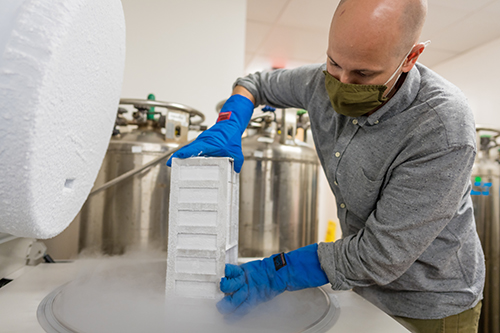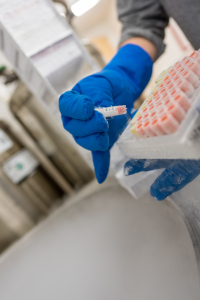Scientists can grow individual cell lines in a dish and study how the coronavirus infects them. And that’s useful as far as it goes. In a sense, however, it’s like studying how a car works by looking at just the carburetor. To gain the most insight, researchers want to study human lung tissue in its full, multidimensional glory, with all cell types represented.
A team of University of Florida Health researchers have developed a method to cryopreserve lung tissue at minus-184 degrees Fahrenheit that gives scientists an important new tool to study how the coronavirus infects individuals.
The method, using commercially available media normally used to freeze cell lines, provides scientists a more complete picture of how the coronavirus and COVID-19 impact lung tissue.
One ingredient of the media is a protein found in Antarctic fish that inhibits the formation of ice crystals.
“When we thaw these lung tissue cells, they retain many of the original properties from before they were frozen,” said Matthew Schaller, Ph.D., an assistant professor in the UF College of Medicine’s division of pulmonary, critical care and sleep medicine. “The cells are still alive and metabolically active, so they can eat and secrete and, importantly, be infected by virus.”
Schaller is the lead author of a paper published last month in the journal JCI Insight that outlines the team’s work.
The research team has obtained, with consent from individual donors, lung tissue samples from a variety of sources. They include patients who undergo lung transplants during which the lungs are
trimmed to properly fit recipients, leaving unused tissue. In addition, researchers use tissue from other types of lung surgery where tissue is cut, or resected, from the organ.
Working since July, researchers now have a library of samples from more than 33 donors, said Schaller. The size of that library might eventually reach 100 donors, their tissue stored in freezers in Schaller’s lab.
The cryopreserved tissue can be stored indefinitely in these tiny vials. (Photo by Louis Brems)With samples from a large variety of people, numerous risk factors for COVID-19 are represented, including smoking, obesity, diabetes and tissue from older individuals. That variety is useful in COVID-19 research as scientists study how the coronavirus behaves differently person to person.
“We’re interested in the inter-individual variability of different humans to COVID-19,” said Borna Mehrad, M.D., a professor and chief of the UF College of Medicine’s division of pulmonary, critical care and sleep medicine who is the paper’s senior author. “It’s a dramatic thing that, out of 100 people who get COVID-19, 80 might develop mild or more moderate infection and 20 of them will be sick enough to be hospitalized; five will be in the intensive care unit and on a ventilator; and two or three of those will die. What is different between the 80 who do well and the five who need the ICU?”
Learning how the coronavirus, and potential therapies, affect different people with a range of risk factors is critically important to researchers. Mehrad said such work is best done by looking at lung tissue as a whole with its different cell types.
“The thing is, cell lines stuck in plastic don’t at all work the same way as cells from a human organ,” he said.
One sample of lung tissue can be divided into hundreds of potential samples so that scientists can run multiple experiments. The cryopreservation technique enables them to perform these experiments over a period of weeks or months and reduces the need to immediately use tissue as it becomes available. So, for example, they might test how infected tissue from the same person responds to different drugs, allowing scientists a greater degree of control over experiments, Mehrad said.
Since samples can be frozen indefinitely, scientists can come back to those from a given individual time and again for experiments.
Schaller and team already have made several intriguing findings using cryopreserved tissue.
The steroid dexamethasone, for example, used widely to treat severe COVID-19, is thought to be effective as a therapy because it reduces lung inflammation. But Schaller’s team found the drug also appears to reduce viral growth in the lungs.
“There’s some other mechanism going on there that needs to be investigated,” Schaller said.
The team also studied the effectiveness of two other drugs, metformin and sirolimus, also known as rapamycin, which were thought to have an effect on viral replication and growth in lung tissue. Using tissue from a handful of samples in their library, UF Health researchers found the drugs were effective at suppressing viral growth in some individuals but had no impact in others.
“That’s exciting because now we can move forward and try to figure out what’s different about those people in which the drugs appeared effective,” Schaller said.
The lung tissue that is cryopreserved is cut into small pieces and prepared so that it takes on the look of a slurry that is subdivided into many different samples. Schaller uses a media that includes among its ingredients a type of biological antifreeze — the one found in the Antarctic fish — that can help preserve the tissue without the formation of damaging ice crystals that might render samples useless.
About 80% to 90% of the tissue remains viable after freezing and can be stored indefinitely.
This deep-freeze process is likely to prove beneficial for research beyond COVID-19.
“We can use it for drug screening or toxicity studies in anything pulmonary-related, even with some other viral infections,” Schaller said. “If another pandemic ever hits, and I hope it never does, this would be useful to screen for other novel viruses.”
This story originally appeared on UF Health.
Check out stories about UF research on COVID-19.


